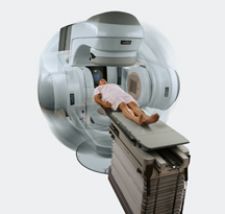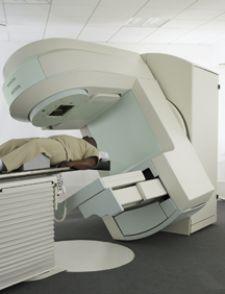
Varian's RapidArc radiotherapy delivers an IMRT treatment in one rotation.
Faster and more precise cancer treatment is one of the primary goals of radiation therapy. Until now, gaining speed has come at the expense of risking accuracy. However, new adaptive radiotherapy and radiosurgery technologies promise the best of both worlds — faster dose delivery with greater precision. But could these new techniques render respiratory gating obsolete?
New Spin on IMRT and IGRT
In more advanced treatment techniques for tumors, such as intensity modulated or image-guided radiation therapy (IMRT and IGRT), clinicians rely on respiratory gating technology to monitor and compensate for tumor movement to deliver more precise radiation doses. But recent advances in adaptive radiotherapy have put a new spin on these techniques.
One of the new systems that reportedly makes it possible to deliver image-guided IMRT two to eight times faster than is possible with conventional IMRT or helical tomotherapy is the recently FDA-cleared RapidArc radiotherapy technology developed by Varian Medical Systems. RapidArc delivers the full dose of radiation in a single full rotation of the gantry. Instead of using multiple fields, which have to be optimized individually, such as in conventional IMRT, or using a slice by slice technique, as with helical tomotherapy, with RapidArc the whole treatment is delivered in a single arc.
“The delivery of the dose can be done within two to three minutes, due to an optimization of dose intensity and leaf – and gantry speed. RapidArc uses an ‘infinite’ number of beams, leading to an improved dose distribution,” said Ben J. Slotman, M.D., Ph.D., professor and chairman, Department of Radiation Oncology at VU University in Amsterdam. “The shorter time for treatment delivery not only [increases patient throughput] but the risk of movement of the patient during treatment is also smaller, and it is, of course, much more comfortable for the patients,” said Dr. Slotman.
According to sources at Varian, RapidArc delivery produces as little as 600 MU per fraction (computed for a 2 Gy treatment fraction), compared to fixed-field IMRT treatments of similar quality that can generate 1,000 to 3,000 MU. RapidArc’s single gantry rotation is said to not only speed treatment delivery but may also result in less leakage, less scatter and lower overall peripheral dose than conventional IMRT treatments. The new system joins the toolset of clinical capabilities supporting static fields, noncoplanar treatments, electron therapy and conventional forms of IMRT, IGRT, stereotactic body radiotherapy (SBRT) and stereotactic radiosurgery (SRS).
The clinical applications that will benefit from RapidArc in the short term, according to Dr. Slotman, are tumors in the brain, head and neck and prostate. “I expect RapidArc to not only replace all current IMRT but that it will also lead to new indications. For example, in patients with brain metastases, it will be very easy to combine whole brain treatment for subclinical disease with treatment of higher doses to areas where metastases are present,” he said.
As for patient outcome using RapidArc, it is too early to present that data. “It is clear that when a dose distribution is more conformal to the tumor or enables better avoidance of critical structures, a higher dose can be given, with better options for cure, and the risk of side effects will be lower,” noted Dr. Slotman. “There is some radiobiological evidence from cell lines, suggesting that if the dose is given in a shorter time, less than two instead of 10 minutes, more tumor cells are killed.”
Another obstacle to overcome is the time-consuming treatment planning that goes into IMRT and IGRT. Although they are regarded as special techniques, requiring more time for planning and delivery, Dr. Slotman anticipates that with RapidArc, “the time needed for both planning, delivery and verification of treatment will decrease.” He added, “Using this technique, image-guided radiotherapy (IGRT) will much more easily become a part of the clinical ‘routine.’”
Other systems, such as HI-ART TomoTherapy by Tomotherapy Inc., are using adaptive radiotherapy to establish IGRT as a standard treatment. HI-ART TomoTherapy is image-guided radiation therapy (IGRT), which couples the most advanced form of IMRT with the accuracy of integrated real-time CT scanning technology and advanced tools for planning and delivering radiation therapy. According to Tomotherapy, this system will allow new treatment advances to be performed, including SRS treatments for brain, spine and body lesions.
Radiosurgery Emerges as a Treatment for Tumors
As real-time image guidance and compact linear accelerators are mounted onto robotic arms, radiosurgery has moved from solely an alternative to brain surgery to a viable noninvasive treatment for tumors throughout the body.
“Improvements in image-guidance technology and robotics have eliminated the need for patients to be fitted with a stereotactic frame and have expanded the use of radiosurgery beyond just intracranial applications,” said Euan S. Thomson, Ph.D., president and CEO, Accuray Inc. “Now radiosurgery is capable of treating tumors throughout the body, including the head, neck, spine, lung, prostate, liver and pancreas.”
One of the key differences between Accuray’s CyberKnife System, equipped with Synchrony respiratory tracking, and IMRT and IGRT techniques is when to use them. IMRT and IGRT use respiratory gating and adaptive radiotherapy, which are well-suited techniques for low-dose/high-fractionation radiotherapy. CyberKnife uses respiratory tracking to deliver submillimetric targeting accuracy, which is optimized for treating earlier stage and confined disease where surrounding critical structure can be clearly identified. Thus, respiratory tracking assists in delivering the highly targeted accuracy required for high-dose/low-fractionation radiotherapy.
Respiratory Tracking: Treating
Moving Targets
Using fiber optic sensing technology, the respiratory tracking technology is able to monitor and track a patient’s respiratory motions in real time. In conjunction with continual image-guidance technology, respiratory tracking can correlate tumor motion with respiratory motion, dynamically directing the linear accelerator to deliver highly accurate radiation beams to moving tumors. Respiratory tracking technology is designed to constantly update its correlation model with each new X-ray image, automatically correcting for any changes in the patient’s breathing patterns. This is said to eliminate the need for complex gating or breath-holding techniques, allowing patients to breath normally during treatment.
Using a custom-designed vest with tracking markers, patient setup is reportedly simplified, especially for multifraction treatments where the vest and markers need to be adjusted only occasionally on subsequent treatments.
Fiducial-Free Future
New tracking algorithms have been developed that enable fiducial-free tracking of tumors in the spine and lung. Researchers are now exploring ways to eliminate the need for fiducials altogether, making radiosurgery completely noninvasive and expanding its uses to other indications, such as prostate and breast cancer.
In the spine, the algorithm enables the real-time image guidance system to pick minute, discrete points on the vertebrae and track each of these points individually to determine patient or tumor movement during treatment.
For the lung, the first soft tissue tracking capabilities have been developed for continually monitoring the location of a lung tumor during treatment, even while the patient breathes normally. Image processing and registration techniques automatically lock onto the tumor directly, tracking it throughout the entire procedure.
To become noninvasive, further advancements in image guidance and treatment planning algorithms are needed. For instance, preoperatively, there may be alternative ways to combine different imaging modalities, such as fusing PET with CTs and MRI, which would enable clinicians to more readily diagnose the tumor and determine its exact location. Additionally, new advanced algorithms and other techniques may be developed to better compare the reference images.
Will Respiratory Gating Become Obsolete?
Will these new advances in adaptive radiotherapy and respiratory tracking render respiratory gating obsolete? Probably not since respiratory gating and adaptive radiotherapy are ‘closely linked,’ in that respiratory gating should be based on IGRT information acquired directly before and during the treatment, says Astrid Hoiss, product manager, IGRT, at BrainLAB Inc., Westchester, IL.
“When the term ‘adaptive radiotherapy’ is used, most people probably think of reacquiring volume data of the target region to update the plan to the new geometric setting on each fraction day,” she said. “Such data acquisition cannot be acquired in real time, and therefore this approach should be limited to treatments where shape changes are the biggest issue, for example, in the pelvic region. ExacTrac Adaptive Gating from BrainLAB enables inclusion of real-time information for treatment delivery to tumors in the lung and liver that is subject to respiratory motion.”
Kulin Hemani, vice president of Siemens Medical Solutions’ Oncology Care Systems Group, explained, “Our position is simply this: Respiratory gating allows you to view the tumor characteristics in three dimensions so you can see the motion of the tumor in the X, Y and Z axes with respect to breathing patterns,” he said. “It’s image acquisition for tumor motion, which is essential for adaptive radiotherapy.”
“The reality is you need to adapt the plan to the patient. With adaptive radiotherapy you can adapt the treatment plan to the new tumor characteristics in real time,” said Hemani. He went to point out that adaptive radiotherapy will not be commercialized without respiratory gating because “respiratory gating is an enabler of adaptive radiotherapy.”
But should radiosurgery become completely noninvasive, could it eclipse the need for respiratory gating and adaptive radiation therapy? Siemens does not seem to think so at this point. It recently reinforced its position on the matter by launching the ARTISTE Solution, a linear accelerator engineered specifically for adaptive radiation therapy. This integrated imaging and workflow solution offers megavoltage, gold-standard CT imaging and cone-beam CT.
At the moment, industry leaders are betting on respiratory gating and adaptive radiation therapy to continue playing a role in radiation therapy as they offer too many benefits to be rendered obsolete.



 December 11, 2025
December 11, 2025 









